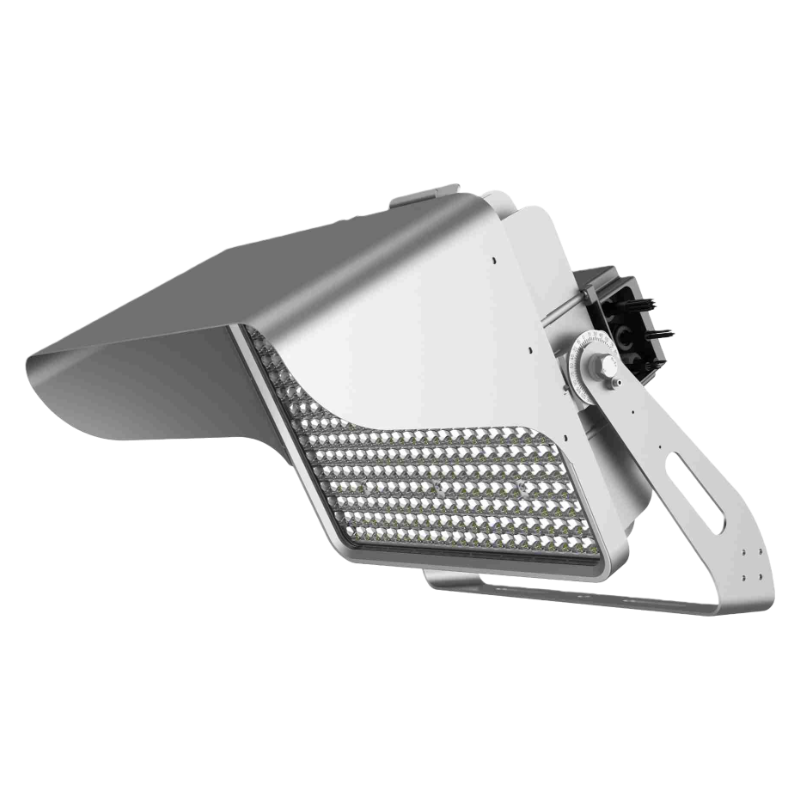How LED Sports Lights Revolutionize Outdoor and Indoor Sports Facilities?
Introduction: The Limitations of Traditional Sports Lighting and the Breakthrough of LEDs
Whether it's an open-air stadium, an indoor basketball court, a swimming pool, or a tennis court, high-quality lighting is essential for the smooth operation of sports venues. Traditional sports lighting has long relied on light sources such as metal halide lamps and high-pressure sodium lamps. However, these lamps have gradually exposed numerous shortcomings: poor illumination uniformity, resulting in alternating light and dark conditions within the field, which impacts athletes' performance; insufficient color rendering, making it difficult for referees to accurately judge the ball's trajectory and athletes' movements; high energy consumption, making lighting electricity bills a heavy burden for large venues; and short lifespans, requiring frequent replacements that not only increase costs but also disrupt event scheduling. With the rapid development of LED technology, LED sports lights, with their unique advantages, are revolutionizing the lighting experience for indoor and outdoor sports venues. So, in what areas have LED sports lights achieved breakthroughs? And how can they drive the upgrade and iteration of sports venues? The following will provide an in-depth analysis of several key dimensions.
Innovation 1: Breaking Through Lighting Standards to Adapt to the Needs of Professional Competitions
The lighting requirements of different sports vary significantly, and from amateur training to international competitions, lighting standards have strict, quantitative indicators. LED sports lights, through precise optical design, break through the limitations of traditional lighting and fully meet the professional needs of various sports venues.
1. High uniformity and glare-free lighting ensure safety and fairness in sports.
International sports federations (such as FIBA and FIFA) have extremely high requirements for uniformity in stadium lighting. For example, basketball venues must have a ground illumination uniformity of at least 0.7, and a vertical illumination uniformity of at least 0.5. LED sports lights utilize an array of multiple LEDs and specialized light distribution lenses to precisely project light, minimizing illumination variations across the field. Furthermore, anti-glare features (such as grilles and hoods) keep the glare index (UGR) below 19, preventing direct light from striking the eyes of athletes and spectators and reducing visual distraction. In a renovation of a professional football club's home stadium, the use of LED sports lights improved the illumination uniformity to 0.85 and reduced the glare index to 16. Players reported a clearer field of view and significantly improved passing and shooting accuracy.
2. High Color Rendering and Adjustable Color Temperature for Authentic Sport Scenes
The color rendering index (Ra) is a key indicator of a light source's ability to reproduce realistic colors. Stadium lighting requires an Ra ≥ 80, and high-definition broadcasts require an Ra ≥ 90. LED sports lights generally achieve a color rendering index of 85-95, accurately reproducing the colors of athletes' uniforms, the texture of the ball, and field markings, helping referees clearly determine whether a play is illegal. Furthermore, LED sports lights support adjustable color temperature (3000K-6500K), allowing for customized lighting atmospheres tailored to different sports and scenarios. High-intensity sports like basketball and tennis can utilize cool white light in the 5000K-6500K range to enhance athlete focus. Small ball sports like badminton and table tennis can be adjusted to 4000K-5000K to enhance the visual contrast of the ball.
Innovation 2: Energy-saving and durable, reducing venue operating costs
Sports venues experience long lighting hours and a large number of fixtures, resulting in energy consumption and maintenance costs that have always been a pain point for operators. LED sports lights' breakthroughs in energy efficiency and lifespan offer significant cost savings for stadiums.
1. Extreme energy savings, significantly reducing electricity costs
LED sports lights offer a luminous efficacy of 150-200 lumens per watt (lm/W), far exceeding the 60-80 lm/W of traditional metal halide lamps. For example, a 5,000 square meter indoor stadium would require 200 400W metal halide lamps, drawing a total power of 80,000W. By replacing them with 150W LED sports lights, only 150 lamps are needed, reducing the total power consumption to 22,500W. Assuming 8 hours of daily use and industrial electricity consumption at 1.2 yuan per kWh, the monthly electricity bill for traditional lamps is 80,000W x 8 hours x 30 days ÷ 1,000 x 1.2 yuan = 23,040 yuan. The monthly electricity bill for LED sports lights is only 22,500W x 8 hours x 30 days ÷ 1,000 x 1.2 yuan = 6,480 yuan, saving 16,560 yuan per month and nearly 200,000 yuan per year.
2. Ultra-long lifespan reduces maintenance and replacement costs
The theoretical lifespan of LED sports lights is 50,000-100,000 hours. Based on 8 hours of daily use, this translates to a service life of 17-34 years. Traditional metal halide lamps, by contrast, have a lifespan of only 10,000-15,000 hours, meaning a service life of less than 5 years. For large stadiums, replacing the lights requires constructing an aerial work platform, with a single maintenance cost reaching tens of thousands of yuan. After a university gymnasium switched to LED sports lights in 2019, no lighting replacements were required until 2025, saving over 150,000 yuan in maintenance costs. Furthermore, LED sports lights offer excellent vibration and high-temperature resistance, ensuring stable operation in the harsh environments of outdoor stadiums, further reducing maintenance frequency.
Innovation Three: Intelligent Control Systems Enable Scenario-Based and Refined Lighting Management
With the advancement of IoT technology, LED sports lights are no longer simply lighting tools; they are deeply integrated with intelligent control systems, bringing unprecedented management convenience and a scenario-based experience to sports venues.
1. One-Click Scene Mode Switching to Adapt to Diverse Needs
The intelligent control system for LED sports lights allows for multiple preset lighting modes, such as "Competition Mode," "Training Mode," "Audience Mode," and "Cleaning Mode." When the venue is hosting an event, simply switch to "Competition Mode" with a single click, and the lighting will instantly adjust to the preset illumination, uniformity, and color temperature parameters. For daily training, switching to "Training Mode" reduces illumination to save energy. For cultural performances, the RGBW four-color LED lighting system dynamically changes color to create an atmosphere. A multi-purpose gymnasium uses an intelligent control system to quickly switch between different lighting modes for different sports, such as basketball, badminton, and volleyball, reducing switching time from the traditional 30 minutes to less than one minute.
2. Remote Monitoring and Energy Consumption Analysis Optimizes Management Efficiency
The intelligent control system supports remote monitoring via mobile app and computer client. Operators can view the operating status of each lamp (such as power, temperature, and fault information) in real time, allowing them to identify problems and initiate prompt repairs. The system also automatically compiles energy consumption data for each time period and generates energy analysis reports, helping operators develop more optimized lighting plans. For example, data analysis revealed that illumination could be appropriately reduced during nighttime training sessions, resulting in a 5% energy saving per month. In addition, some high-end systems also feature crowd-sensing capabilities, automatically adjusting lighting zones and brightness based on the number of people in the venue, further achieving refined energy savings.
Real Case Study: The Real Results of LED Sports Lighting Empowering Stadium Upgrades
In 2022, the stadium at a prefecture-level sports center underwent a lighting renovation, replacing 400 existing 1000W metal halide lamps with 300 300W LED sports lights. The renovation increased the average illumination from 200 lux to 500 lux, with a uniformity of 0.88, meeting the broadcast requirements for national-level football matches. Annual electricity bills were also reduced from 1.2 million yuan to 360,000 yuan, with an estimated payback period of five years. Furthermore, the intelligent control system enables rapid switching between various scenarios, such as competitions, training, and events, improving operational efficiency by 40%.
Due to the humid environment at an indoor swimming pool, traditional lighting frequently broke down, resulting in annual maintenance costs exceeding 80,000 yuan. The switch to IP67-rated LED sports lights in 2023 not only resolved the issue of use in humid environments but also restored the true color of the pool water through high color rendering, reducing visual fatigue for athletes. Energy consumption was also reduced by 60%, saving 50,000 yuan in annual electricity bills and reducing maintenance costs to almost zero.
Conclusion: LED sports lights are leading a new revolution in sports venue lighting.
From meeting the lighting standards of professional events, significantly reducing operating costs, and enabling refined management through intelligent control systems, LED sports lights are profoundly transforming indoor and outdoor sports venues in multiple dimensions. They not only enhance the sports experience and event quality, but also create significant economic value for venue operators, while also aligning with the trend toward green energy conservation. With the continued advancement of LED and intelligent control technologies, LED sports lights will enable more precise light control, richer interactive scenarios, and higher energy efficiency, becoming a core driver in the transformation of sports venues towards smart, low-carbon operations. For sports venues planning or upgrading their lighting systems, choosing LED sports lights has become an essential choice to enhance their competitiveness.











